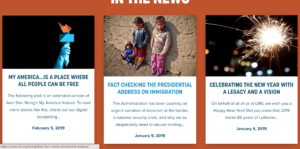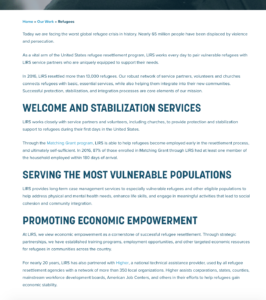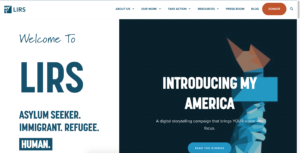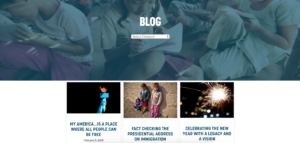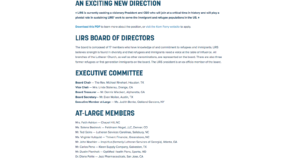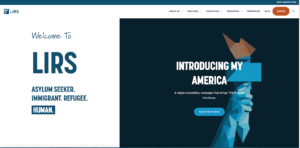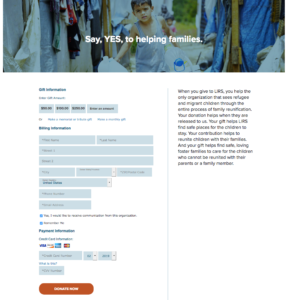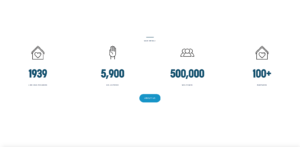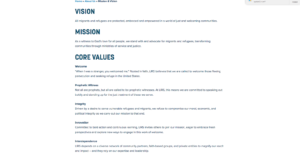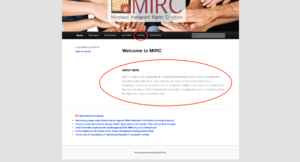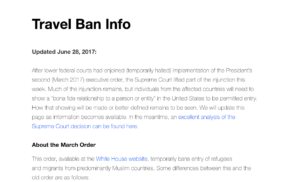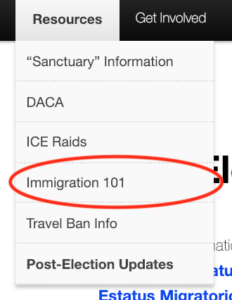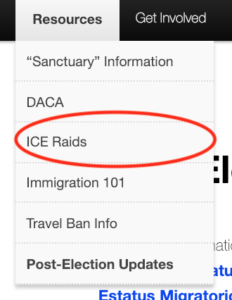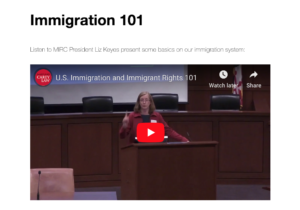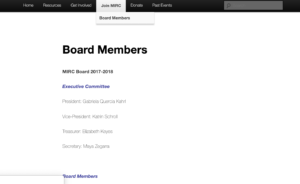Upon analyzing Catholic Charities website (www.catholiccharities-md.org), Catholic Charities is a non-profit organization that provides care and services to people living in Maryland. Their values include “to love, to serve, to teach, and to work for justice.” In addition to their mission statement, the purpose of Catholic Charities is to persuade people into donating or volunteering for the organization. The authors of the Catholic Charities website have credibility with this kind of work. The author includes links to news articles and current events and includes images to capture the audience’s attention. The author of the website uses rhetoric to be able to have the website stand out to their audiences, inform the audience of the organization’s purpose, and help convey the genre and context to reach relevance in today’s society.
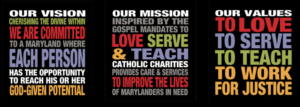
The primary audience that Catholic Charities strives to appeal to would be the donors and volunteers. When you first come to the website, the first thing you will see is their mission statement on the right side of the screen and a blue bar that goes across the page. The first two words that are read on the blue bar are “Donate” and “Volunteer.” Underneath of the blue bar is a graphic with a button that says, “Stand With Us.” Pressing the button leads you to a page that says, “Turn compassion into action” and on the right side of the screen there and three buttons with three different colors. The first button is green and has the word “GIVE.” Green could be associated with money and in this case, it is a good choice for the author to use the color to receive donations. The second button is blue and has the word “VOLUNTEER” which is another important aspect for Catholic Charities. Lastly, the third button is orange and has the words, “LEARN MORE” which takes you back to the homepage. This was a purposeful choice that the author made because when on the “Stand With Us” page, the navigation bar is not accessible, which means that the only options that a person could do is to either give or volunteer.

The secondary audience that Catholic Charities could appeal to would be advocates, immigrants/refuges, senior citizens, people with disabilities, and people who would need poverty relief or housing and shelter. The website’s secondary audience is a wide range because of the amount of services that they do offer. “Advocate” is the third word on the blue navigation bar on the homepage. The tab takes you to a page that informs the audience on Catholic Charities advocacy and public policy. The page also includes advocacy alerts, workshops, and information on how to contact the organization. Next to the “Advocate” button on the navigation bar is the word, “Find Help.” The tab leads you to a page that has a list of services that Catholic Charities has to offer. On the top of the page, it has a tagline that reads, “Find The Help You Need From One of Our 80 Programs.” The author purposely choose to put the tagline on the top and bottom of the page to show audiences that the organization does offer a wide range of services to appeal to anyone who needs help.
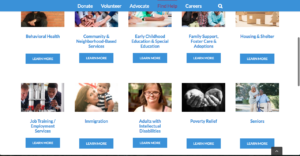
Catholic Charities’ medium is a website. The author most likely chose a website platform because it would be easily accessible to anyone who could access a phone or a computer. The primary reason for why the author chose a website would be to easily collect donations and to have volunteers contact the organization without having to find a location to go to. A secondary reason for the website is to provide people with resources. These resources include help with immigration, poverty relief, housing and shelter, community and neighborhood based services, and 80 other services. The historical convention for this website is that with the ongoing issues on immigration and refuges within the United States, people need to be able to find resources without fear of “being caught.” They want to be discreet with their actions for providing themselves with a better life.
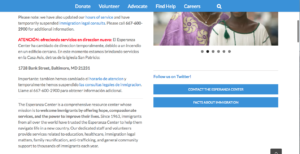
Overall, Catholic Charities website is easy to navigate through. The tabs are straight forward and takes you to where you need to go. The website can be word heavy, however, it compensates with images and color. The website sticks to the same color scheme, most likely to ensure people that they are still on the same website. This would also help with people who have disabilities. The website also has credibility because it provides information and updates on government actions. The website is also well organized and keeps everything condensed into six tabs. The website could improve on adding auditory aids or add an option for different languages. This would satisfy a bigger range of audience and possibly bring more traffic to the website.
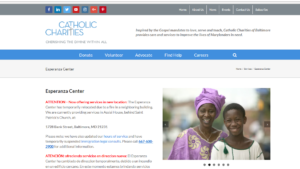 le bias in favor of Catholics. This logo gives legitimacy to the website, and in turn to the Esperanza Center, with Catholic Charities being a well known and well established charitabl e Non-Profit organization that has operated for decades. It is clear from this logo, the company’s reputation, and from the layout of the navigation bar that the site targets religious people with money as it’s primary audience. The logo includes below it the words “Inspired by the Gospel Mandates” and “Cherishing the Divine Within All” (“Esperanza Center.”), which respectively is the tagline of the Baltimore Catholic Charities Branch and the Catholic Charities overall. The Navigation bar gives further insight, with Donate coming first, followed by Volunteer and Advocate. It is clear that those with time and/or funds to spend on Catholic Charities, in this case the Esperanza Center in particular, are the Primary Audience the webpage is created for. All over the website there are Volunteer and Donate Buttons, practically on every section of the website. Its purpose is clearly to gain the resources needed to run the Center and better help immigrants. The name of the Center is also highly emphasized, the words Esperanza Center appear all over the website, in various colors and sizes, as well as in images to ensure the name is prominent and easily remembered. The most important information, such as name, location, and contact options of the represented Esperanza Center are all placed above the fold and in close proximity to each other, in text that draws emphasis to them in English and Spanish. This use of both languages points to the secondary audience, though the site seems to be shifting them more towards a primary audience role: immigrants. It is clear that they are currently secondary as the bulk of the website is geared towards recruiting volunteers and donors and is in English. However, there are videos and important text in Spanish and intent stated that more will be offered in Spanish. There are also various links that lead services and their contact information that Esperanza offers and options to get the information in Spanish.
le bias in favor of Catholics. This logo gives legitimacy to the website, and in turn to the Esperanza Center, with Catholic Charities being a well known and well established charitabl e Non-Profit organization that has operated for decades. It is clear from this logo, the company’s reputation, and from the layout of the navigation bar that the site targets religious people with money as it’s primary audience. The logo includes below it the words “Inspired by the Gospel Mandates” and “Cherishing the Divine Within All” (“Esperanza Center.”), which respectively is the tagline of the Baltimore Catholic Charities Branch and the Catholic Charities overall. The Navigation bar gives further insight, with Donate coming first, followed by Volunteer and Advocate. It is clear that those with time and/or funds to spend on Catholic Charities, in this case the Esperanza Center in particular, are the Primary Audience the webpage is created for. All over the website there are Volunteer and Donate Buttons, practically on every section of the website. Its purpose is clearly to gain the resources needed to run the Center and better help immigrants. The name of the Center is also highly emphasized, the words Esperanza Center appear all over the website, in various colors and sizes, as well as in images to ensure the name is prominent and easily remembered. The most important information, such as name, location, and contact options of the represented Esperanza Center are all placed above the fold and in close proximity to each other, in text that draws emphasis to them in English and Spanish. This use of both languages points to the secondary audience, though the site seems to be shifting them more towards a primary audience role: immigrants. It is clear that they are currently secondary as the bulk of the website is geared towards recruiting volunteers and donors and is in English. However, there are videos and important text in Spanish and intent stated that more will be offered in Spanish. There are also various links that lead services and their contact information that Esperanza offers and options to get the information in Spanish.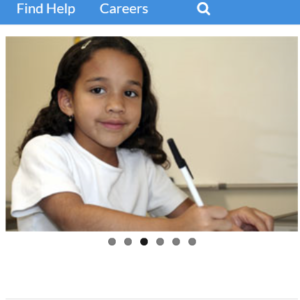 ou continue down below the fold. Back above the fold, on the right side, a rotating box of images showing various immigrants utilizing the offered services as well as the building that houses Esperanza center is shown prominently. The dots under the rotating picture box indicates the option to shift the images, and hovering over them produces arrows on either side of the images that also indicate an option for lateral movement. And past this on the far right is a scroll bar, notifying users that there is more to the website than the initial view. As the consumer
ou continue down below the fold. Back above the fold, on the right side, a rotating box of images showing various immigrants utilizing the offered services as well as the building that houses Esperanza center is shown prominently. The dots under the rotating picture box indicates the option to shift the images, and hovering over them produces arrows on either side of the images that also indicate an option for lateral movement. And past this on the far right is a scroll bar, notifying users that there is more to the website than the initial view. As the consumer 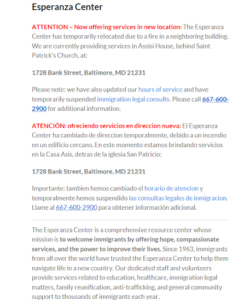 scrolls down through the site, they will notice that the linguistics were carefully planned with clear and simple language with text of a fair size and non-seriffed font, lending to easier reading. There are also prominent translations in Spanish for more vital or useful information being provided. Though it is not yet in place, there is intent stated to translate more of the website into Spanish in the near future, which makes it more accessible to the large Spanish speaking immigrant population. There doesn’t seem to be any option for text to voice on this site, and there isn’t much Spanish. The midsection of the page contains button in green for upcoming events, and below it are tabs with more in depth information about the Esperanza Center and its’ history, its’ goals, and its’ services. Each has a plus sign next to them in black and white signifying that more information can be accessed by clicking it and less can be seen by clicking the minus sign that appears once you’ve clicked the plus sign. Most
scrolls down through the site, they will notice that the linguistics were carefully planned with clear and simple language with text of a fair size and non-seriffed font, lending to easier reading. There are also prominent translations in Spanish for more vital or useful information being provided. Though it is not yet in place, there is intent stated to translate more of the website into Spanish in the near future, which makes it more accessible to the large Spanish speaking immigrant population. There doesn’t seem to be any option for text to voice on this site, and there isn’t much Spanish. The midsection of the page contains button in green for upcoming events, and below it are tabs with more in depth information about the Esperanza Center and its’ history, its’ goals, and its’ services. Each has a plus sign next to them in black and white signifying that more information can be accessed by clicking it and less can be seen by clicking the minus sign that appears once you’ve clicked the plus sign. Most 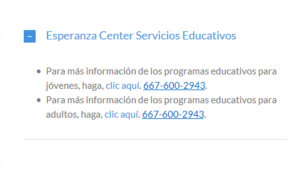 of the options are written in English; though one is in Spanish and provides a phone number to call for information on education for both adults and children, presumably also given in Spanish. For the most part this list of services are meant to garner pro-bono workers and volunteers to provide the services, rather than to explain them to immigrants.
of the options are written in English; though one is in Spanish and provides a phone number to call for information on education for both adults and children, presumably also given in Spanish. For the most part this list of services are meant to garner pro-bono workers and volunteers to provide the services, rather than to explain them to immigrants.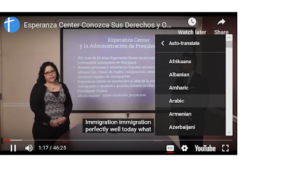 f communication, but it should have an option for translation on site or for text to speech. There is a lot of gesturing, facial expression, and body language in the video, as well as friendly interaction and explanation from both a male and a female. There is a scroll bar on the site’s right side to indicate the option to scroll down. The images above the options directly
f communication, but it should have an option for translation on site or for text to speech. There is a lot of gesturing, facial expression, and body language in the video, as well as friendly interaction and explanation from both a male and a female. There is a scroll bar on the site’s right side to indicate the option to scroll down. The images above the options directly  below the video are gestural and are not the most common but common enough to help signify what the buttons do. The checked box for example is something seen on various sites to denote mail or email. Both the text and buttons use contrast to stand out from the colors of the buttons against the plain white background. The brightly colored and emphasized text contrast is used
below the video are gestural and are not the most common but common enough to help signify what the buttons do. The checked box for example is something seen on various sites to denote mail or email. Both the text and buttons use contrast to stand out from the colors of the buttons against the plain white background. The brightly colored and emphasized text contrast is used 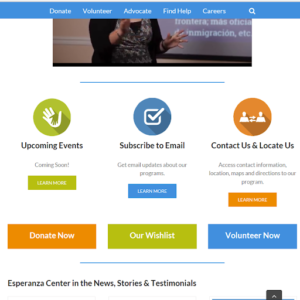 to great effect to pull the eye to the most relevant, beneficial, and important information or points for the company’s goals. Just below this, it is again made clear the website’s main goal of gaining donors and volunteers with far larger size than the buttons above them and opposite color patterning with buttons “Donate Now”, “Our Wishlist”, and “Volunteer Now” (“Esperanza Center.”). Finally at the bottom of the page, there are testimonials and more links to get involved in Catholic charities.
to great effect to pull the eye to the most relevant, beneficial, and important information or points for the company’s goals. Just below this, it is again made clear the website’s main goal of gaining donors and volunteers with far larger size than the buttons above them and opposite color patterning with buttons “Donate Now”, “Our Wishlist”, and “Volunteer Now” (“Esperanza Center.”). Finally at the bottom of the page, there are testimonials and more links to get involved in Catholic charities.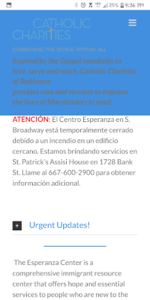 o sign up to volunteer. It is on Catholic Charities’ site, as one of their many projects, giving it a better chance of being noticed than it would have on its’ own. It has a mobile version as well, which contains more Spanish text on the homepage than the desktop site does. I am not entirely sure why. However, it is possible that it could be because people are likely to have a phone, or access to one, than a laptop or other personal computer, and so more people will be able to use it and find information on the Esperanza Center in an easy to consume manner. Note that the mobile site has a major flaw, in that the mission statement and logo of Catholic Charities covers about a third of the page once you scroll below the fold. This is annoying and unhelpful at best, and detrimental to user’s ability to read the text at worst. It is distracting and a poor design choice that limits the site’s usefulness.
o sign up to volunteer. It is on Catholic Charities’ site, as one of their many projects, giving it a better chance of being noticed than it would have on its’ own. It has a mobile version as well, which contains more Spanish text on the homepage than the desktop site does. I am not entirely sure why. However, it is possible that it could be because people are likely to have a phone, or access to one, than a laptop or other personal computer, and so more people will be able to use it and find information on the Esperanza Center in an easy to consume manner. Note that the mobile site has a major flaw, in that the mission statement and logo of Catholic Charities covers about a third of the page once you scroll below the fold. This is annoying and unhelpful at best, and detrimental to user’s ability to read the text at worst. It is distracting and a poor design choice that limits the site’s usefulness.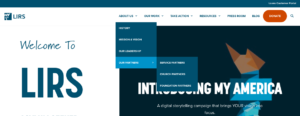 r. This indicates that the intended audience are people with money who can afford to donate. The website also provides a link that is called “our partners.” Our partners include the church partners that are affiliated with certain activities that the LIRS may provide. The donate button also serves a purpose for possible members of a church that works collaboratively with the LIRS. Members of the
r. This indicates that the intended audience are people with money who can afford to donate. The website also provides a link that is called “our partners.” Our partners include the church partners that are affiliated with certain activities that the LIRS may provide. The donate button also serves a purpose for possible members of a church that works collaboratively with the LIRS. Members of the 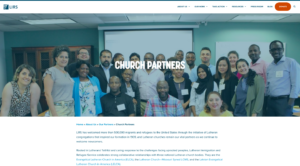
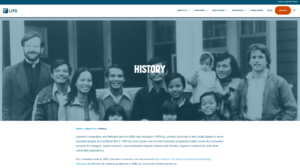 has a religious “tone” to the organization as a whole. Refugees and Immigrants who follow a specific religion may favor the fact that it is a Lutheran non profit, for they understand how churches give back to the community and would prefer to be affiliated with this influence.
has a religious “tone” to the organization as a whole. Refugees and Immigrants who follow a specific religion may favor the fact that it is a Lutheran non profit, for they understand how churches give back to the community and would prefer to be affiliated with this influence. 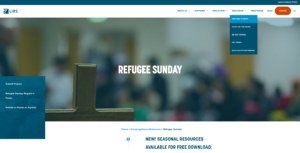
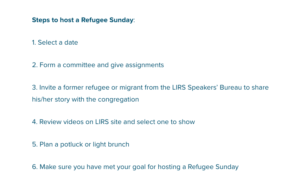
 s internet and technology, so for the LIRS to be using the web as their main source of interaction shows they are trying to reach a mass audience. In order to further reach a mass audience of all demographics, the website provides a tiled mosaic structure of a “digital storytelling campaign” to welcome fellow immigrants. The campaign consists of refugees who have previously gone through the LIRS proving the credibility and to shed a positive light on the program.
s internet and technology, so for the LIRS to be using the web as their main source of interaction shows they are trying to reach a mass audience. In order to further reach a mass audience of all demographics, the website provides a tiled mosaic structure of a “digital storytelling campaign” to welcome fellow immigrants. The campaign consists of refugees who have previously gone through the LIRS proving the credibility and to shed a positive light on the program.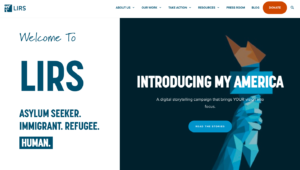
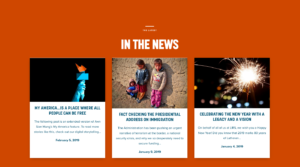
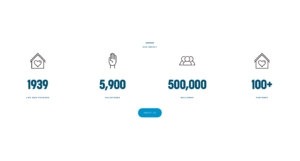 The overall facts that readers need to know are dead center, in large text, with no other distractions or information surrounding it. This is done purposefully so people can scroll and analyze the page with ease.
The overall facts that readers need to know are dead center, in large text, with no other distractions or information surrounding it. This is done purposefully so people can scroll and analyze the page with ease. 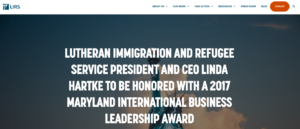

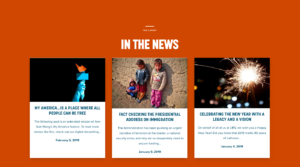 vs.
vs. 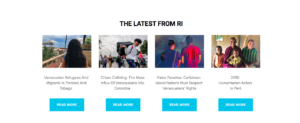
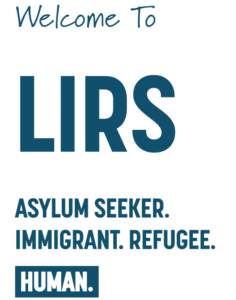

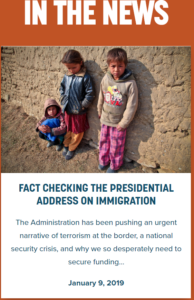
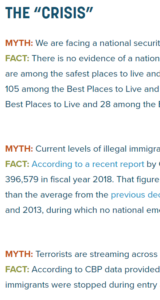

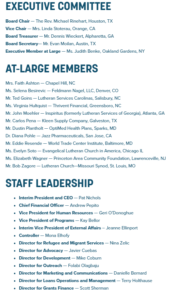
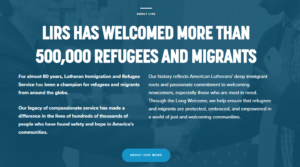
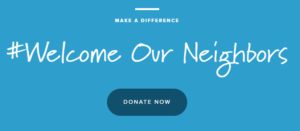



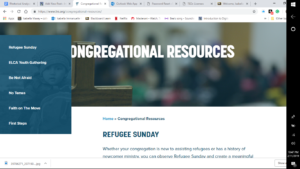
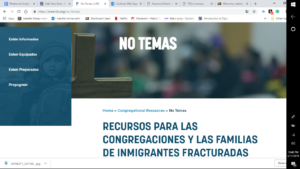
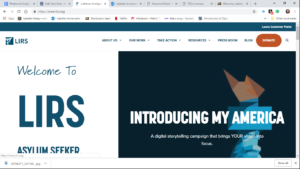
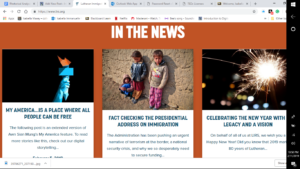
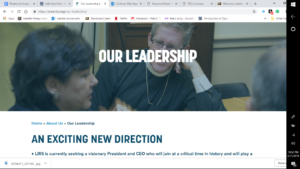
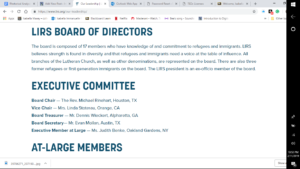

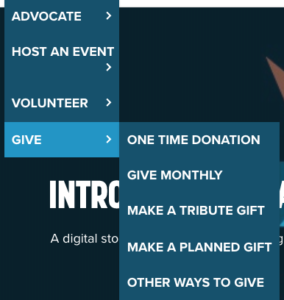
 In addition, at the top right corner above the navigation bar is a link for “Loans Customer Portal”, where a refugee can receive a loan, another great resource. It is known that the donors and volunteers are the primary audience because there is a bigger focus in the website to donate and how to do that as well as the ways available to volunteer. If the primary audience was the refugees then there would be a bigger focus on the resources and what the organization can offer, which the website does not do.
In addition, at the top right corner above the navigation bar is a link for “Loans Customer Portal”, where a refugee can receive a loan, another great resource. It is known that the donors and volunteers are the primary audience because there is a bigger focus in the website to donate and how to do that as well as the ways available to volunteer. If the primary audience was the refugees then there would be a bigger focus on the resources and what the organization can offer, which the website does not do.